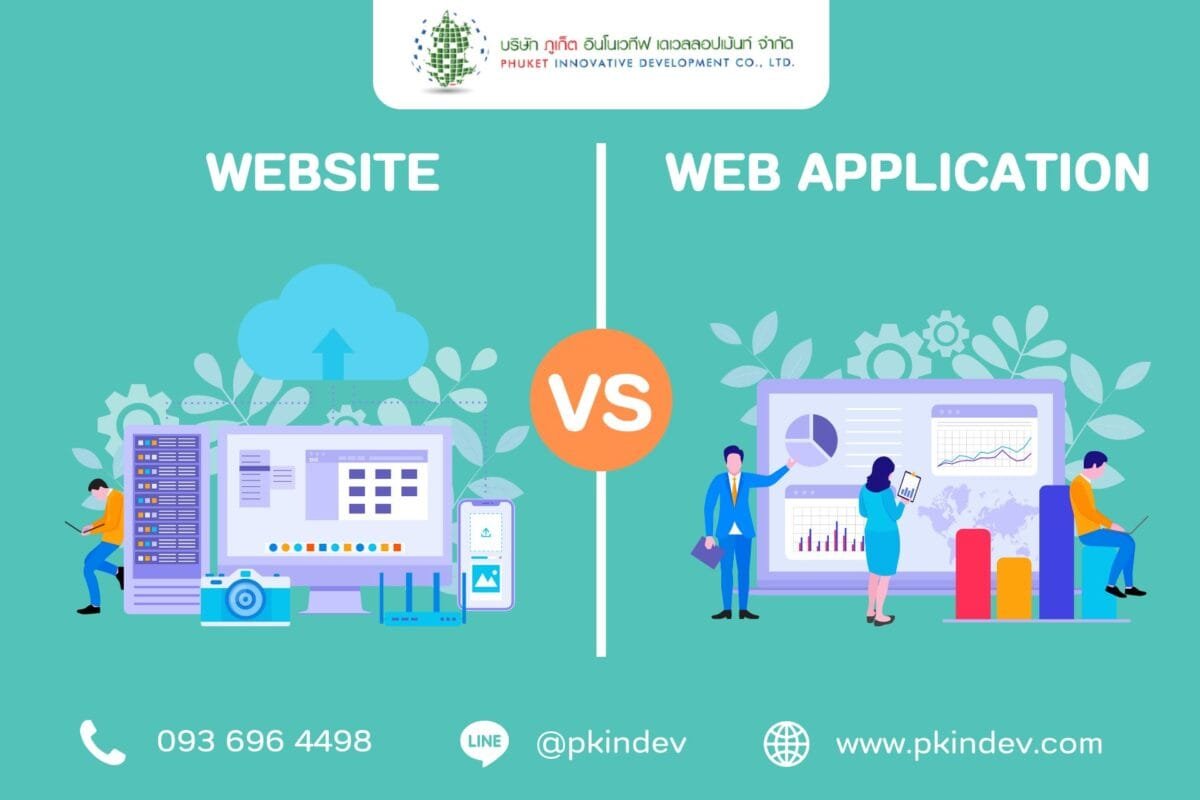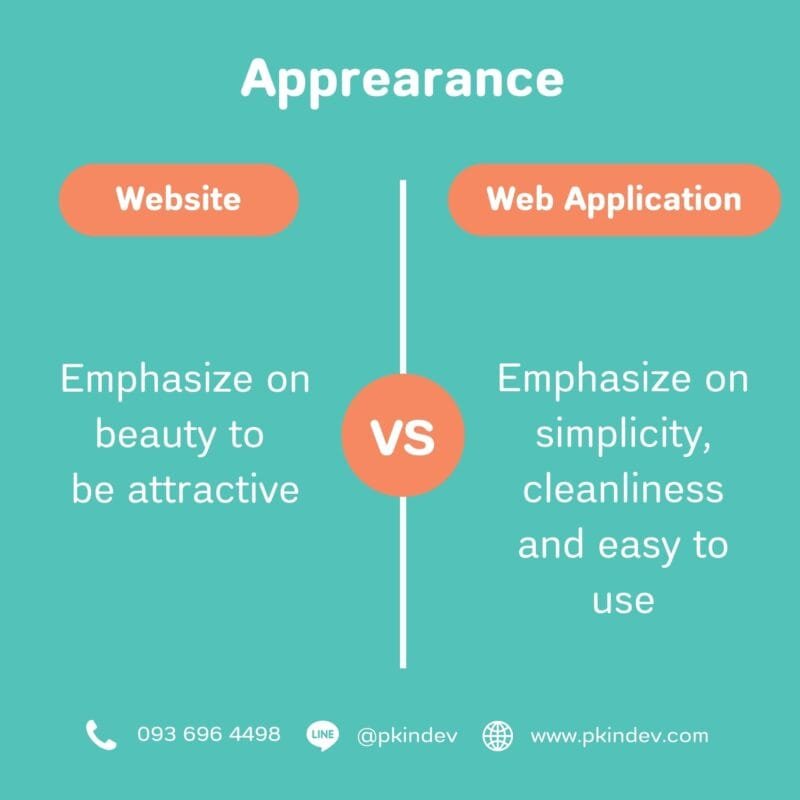
In this era, if we talk about the term ‘Web’ or ‘Website,’ almost nobody would be unfamiliar with it because it’s a widely used term regardless of age, especially for the younger generation who grew up with the internet. However, when it comes to the term ‘Web Application,’ many people might still be confused about what it is and how it differs from a typical website.
Therefore, we would like to provide additional explanation to clarify the confusion about how ‘Web Application’ differs from a ‘Website.’ So, what exactly is a ‘Web Application’ and what is a ‘Website’ that we use every day?
What is a Web Application?
A Web Application is an app that is designed to be accessed directly through a web browser without the need to download the full application onto a device. This generally results in lower resource consumption overall and allows for quick access.
Certainly, within the Web Application itself, there is often optimization for faster operation compared to traditional application opening, resulting in a user-friendly interface and relatively easy usage. Nowadays, there are a wide variety of Web Applications used globally, from university-level projects to company-owned applications.

The Differences between Website and Web Application
Why do people often misunderstand that Websites and Web Applications are the same? When both Websites and Web Applications are accessed from the same place, which is the Web Browser itself, it’s not surprising that everyone gets confused. But did you know that Websites nowadays are almost entirely transformed into Web Applications?
To better understand, let’s take a closer look at the differences between Websites and Web Applications.

Perspectives of Usage:
- Website: It is a collection of web pages designed to present information, data, and link data to various subpages according to the format and settings of the website. Websites primarily focus on allowing people to ‘view’ as their main function.
- Web Application: It serves a similar purpose to websites but can also function as applications. It focuses more on allowing people to ‘use’ rather than just view. For example, web applications for calculation, timekeeping, or translation. Typically, web applications are cleaner, faster, and more visually appealing than regular websites because they prioritize usability in one specific area.

Appearance:
- Website: Often emphasizes beauty and attractiveness. Some websites may be somewhat complex, with various links allowing visitors to navigate within the website.
- Web Application: Focuses on simplicity and cleanliness. Sometimes, web application interfaces display programs and functions directly without much decoration, aiming to enable users to use them as quickly as possible.

Background Operation:
- Website: Generally, each webpage of a website tends to be relatively simple. Emphasis is placed on decoration and formatting to suit the preferences of visitors or the content of the website.
- Web Application: More complex and intricate, often requiring specialized expertise to manage and design the application, including user-friendly internal functions. Designing something complex to be user-friendly is what makes something users never used before ‘usable’.
Understanding these differences at a certain level will likely dispel any doubts about how these two differ.
The Operation of Web Applications
Generally, if you are not a backend developer, you might understand that creating a web application is easy and not much different from creating a website. However, let’s delve deeper into how things work behind the simple and user-friendly interface.
The Components in the Operation of Web Applications
Web applications typically have four main components that can be seen, including:
- Web Application: The Web Application serves as the initial gateway for receiving data from users. It can be customized or modified in various ways, such as for calculating various values, membership systems, eCommerce systems, Payment Gateway systems, maps or 360-degree camera angles, CRM data storage systems, and many other purposes, depending on the creator’s intended usage direction.
- Web Browser: A tool for opening Web Applications, which comes in various options such as Google Chrome, Firefox, or Microsoft Edge, among others. These browsers can currently operate on both computers and smartphones.
- Web Server: A server system that provides services to various websites and web applications, handling the transmission of data between users and web applications. Examples commonly encountered include the Apache Webserver and IIS Web server.
- Database: Data storage from the service provider’s side, responsible for storing necessary data. Sometimes, a separate Database Server is set up for convenience in monitoring, managing, and securing the web application.
Operating Principle:
Users utilize a Web Browser to access the Web Application. The Web Application then retrieves necessary data through the Web Server, and the Web Server may also retrieve essential data, such as user information and customer data, from the Database.
Summary:
Certainly, all of the above is just a brief explanation of how each component works, and the components of the entire process may undergo deep changes according to expertise, proficiency, as well as the budget and expenses for creating the Web Application. Therefore, it’s crucial in Web Application development to ‘create what is needed, which can be accessed through a Web Browser.’ Hence, what can be crafted is vast, ranging from games, travel applications, loan calculators, to celebrity gossip trackers, and more. Instead of spending money on both website development and additional application costs separately, wouldn’t it be better if you create a Web Application that serves both as a mobile app and a website in one, addressing all user needs comprehensively?
……………
Phuket Innovative Development is pleased to offer our services. We specialize in programming, websites, and mobile applications tailored to your satisfaction. Our services include Web Apps, Mobile Apps, Websites, E-Books, print media, and various other platforms.
We also provide various software for organizational management, such as accounting software, HR management software, clinic management software, hotel management software, POS (Point of Sales) systems, factory management software, spa management software, dormitory management software, restaurant management software, and more.
Phuket Innovative Development Co., Ltd. has been awarded the ISO/IEC29110 standard and numerous accolades.
For further inquiries, please contact us at 093 696 4498.
E-mail: mongkontep@pkindev.com, Website: www.pkindev.com, Line OA: https://lin.ee/po8XduU
